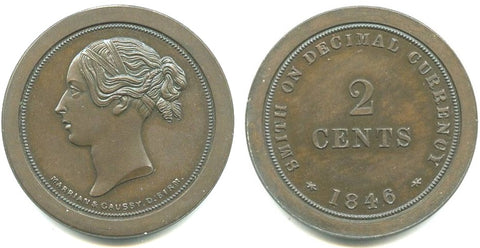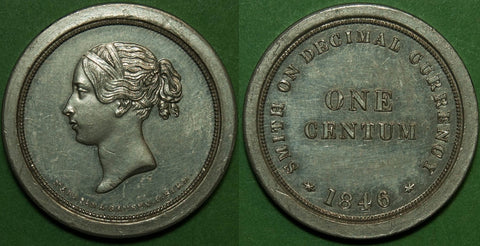The First British Decimal Coins
The first country to decimalise was Russia in 1704 which introduced a currency based on 100 Kopeks = 1 Rouble. By the end of the century a decimal currency was either implemented or was actively being considered by a number of countries. e.g. America had used a decimal currency from the earliest US coins in 1792 with 100 Cents = 1 Dollar and in 1795 the French had dropped the Livre in favour of a system based on 100 Centimes = 1 Franc. More countries followed suit over the next few decades.
Unsurprisingly, in line with other countries there was a call to decimalise the currency in Great Britain and so in 1824, the MP for Staffordshire, Sir John Wrottesley, proposed a decimal currency comprising 100 farthings equal to a double shilling and 10 double shillings equal to a pound. i.e. 1000 farthings were equal to a pound which wasn’t too dissimilar from the existing 960 farthings to the pound, but nevertheless the idea was rejected by Parliament.
The next move to decimalise came in 1841 with the foundation of the Decimal Association. Its aims were the adoption of a decimal currency together with use of the SI metric system which had been introduced in France at the end of the previous century. Obviously they had some sort of impact, because this decade saw the first decimal coins struck in this country.
The first decimal coins were not made at the Royal Mint, but by the Birmingham silversmiths Marrian & Gausby in 1846. The first coins were struck in denominations of 1, 2, 5 & 10 cents, all undated. Freeman (The Bronze Coinage of Great Britain, p.186, 1985) lists two of these coins, both in brass. A10c with all detail incuse, the obverse bearing a bust of Victoria facing left and the reverse with the legend SMITHS DECIMAL CURRENCY (F811) and a 5c reverse uniface with 5 CENTS in two lines, again incuse (F812). A boxed set(?) of these initial strikings in gilt copper was sold at St. James’s auction 29 lot 157(part) on 29th September 2014 which contained 1c, 2c (x2), 5c and 10c, all with a portrait on the obverse. All pieces had a wide raised rim.
The 10c and 5c are shown below (these and subsequent images not to scale).


The legend used on the 10 cent piece caused the Royal Mint to object as they had the sole prerogative to strike currency.
Their opinion obviously won the argument as Marrian & Gausby then produced a second set of dies. The obverse now had their name added to the obverse below the bust (except on the 1 cent), while the reverse had the legend amended to SMITH ON DECIMAL CURRENCY which was applied to the field for all denominations, surrounding the value in two lines with the date 1846 below. A wide raised rim was again used except for the 1 cent which was narrow. All were struck in copper with an inverted die axis. Again they were struck in denominations of 1, 2, 5 & 10 cents, with the addition of a new denomination - One Centum. The diameters of these are 22, 29.5, 36, 41 and 27.5mm respectively. The hair detail is slightly different for all 5 denominations, most notably seen around the bun.



The Centum was struck in white metal. What its value was supposed to represent in sterling terms is uncertain. C W Peck in a footnote to p.479 of English Copper, Tin and Bronze Coins in the British Museum 1558-1958, 2nd ed (1964) proposed that it represented a decimal shilling of 50 cents, with a pound equal to 20 centums and 1000 cents to the pound. A concept I find difficult given the near universal acceptance of a cent being a 1/100th part of the whole. But then, with a copper 10 cents having to equal two shillings (a large silver value at the time) using a 100 cent pound, the idea of 1000 cents (or preferably milles) to the pound is justifiable.
A boxed set of these five coins formed the second part of the St. James’s lot (see above).
Although not adopted as a design for circulating currency, the question of a British decimal currency would not go away and within two years the Mint had produced its pattern ‘Godless’ florins, leading to the currency issue of the same in 1849.
Restrikes of these Marrian & Gausby pieces were made at a later date and in metals other than copper. The only attested strikings were those made in 1888 by E. Shorthouse whose letter to L Forrer in 1909 indicated that the dies were found in the late Joseph Moore’s workshop, but that only the 10c dies were fit for use, the others being completely rusted (see Peck p.479 for a more complete account). On that day a total of 9 each were struck in silver, bronze and copper. These were struck with the opposite die axis (en-medaille) and on thicker flans to avoid confusion with the originals. That leaves the question unanswered of when, where and by whom the gold, silver and white metal restrikes of the 2c and the 10c in white metal were made. Further research is clearly required.



Robert Pearce
Author